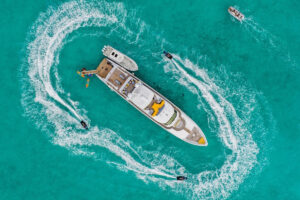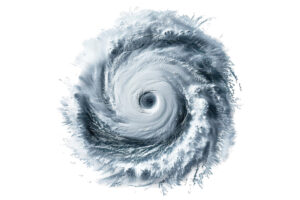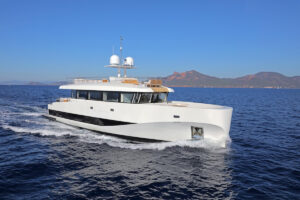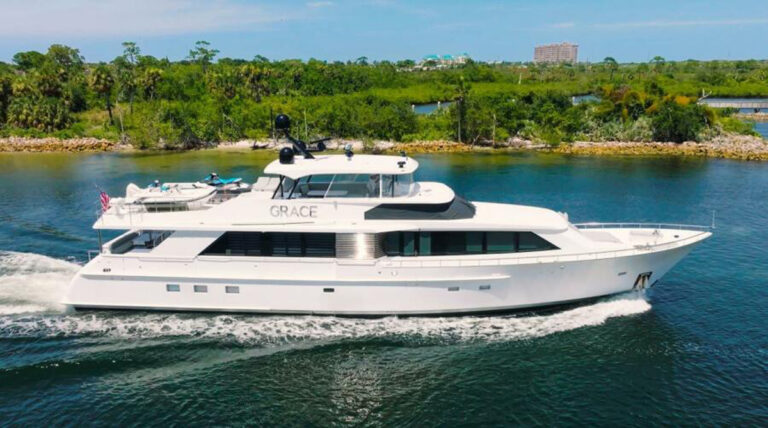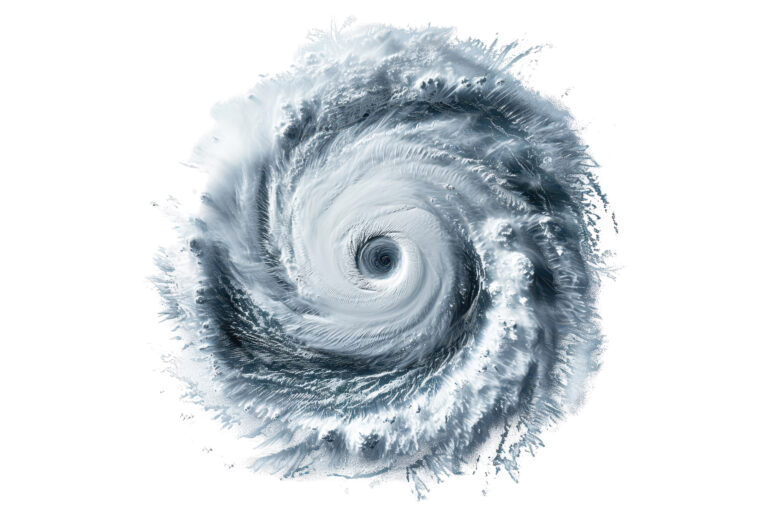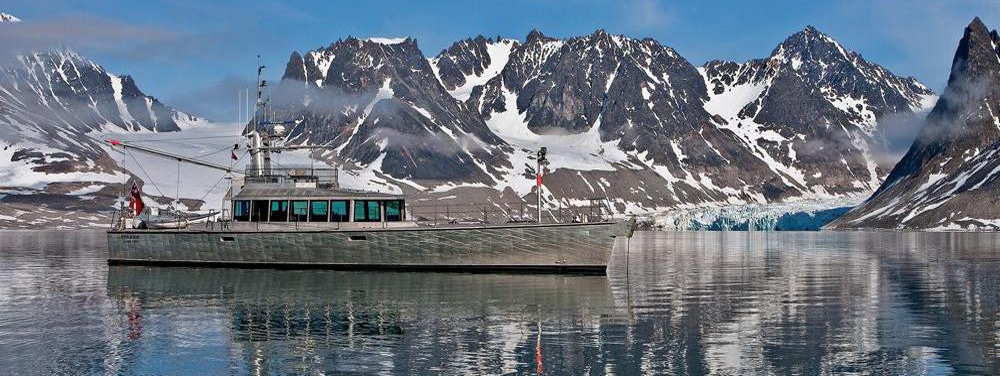
Wind Horse
It is 1930, Norwegian summer time. We are located at 79.35 north latitude, a little over 600 miles from the North Pole. Behind us lie the Svalbard Islands, midway between northern Norway and Greenland. Our goal is 80 degrees north and the Arctic ice pack. Right now this goal is very much in doubt.
Fog has reduced the visibility we need to find open leads in the ice. At present we can see at most a quarter of a mile. And an unforecast wind is starting to blow at right angles to our course from the west. Wind Horse, our FPB 83 motoryacht, is at idle, while we watch the weather and analyze the risk factors.
That you can get this close to the Pole is amazing. If we were in the Southern Hemisphere, we’d already be on the ice sheets of Antarctica at 65 degrees latitude. In Greenland, we’d have been stopped by pack ice hundreds of miles south, and Alaska’s Glacier Bay is 1,100 miles closer to the equator than our present position. But the west coasts of the Svalbard Islands are kissed with the remnants of the Gulf Stream, so this area is typically navigable—with a great deal of care—by the middle to the end of July.
Caution is the watchword. We are on our own. If there is a problem, we either sort it out ourselves, or suffer the consequences. There are no technicians to make service calls, nobody to rescue us if we set off the EPIRB. And if we make a mistake judging the weather, and become trapped by the ice pack, we are here, at best, until next summer.
Enveloped in the warm, dry cocoon of Wind Horse’s interior, surrounded by a tough metal hull with a double bottom, five watertight bulkheads, and 3/4-inch-thick windows, it is easy to lose touch with the reality of the far north. But we know the west wind can quickly close the open leads through which we have worked to arrive at this point.
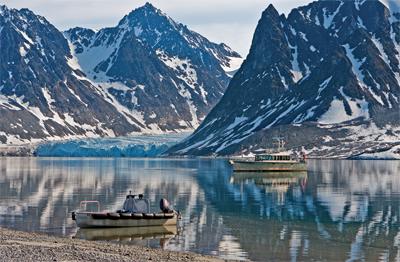
Each July, 15 to 20 yachts make the 500-nautical-mile trip from northern Norway to the Svalbard Islands. Most are constructed of metal, and other than Wind Horse, all are sail. Permission to visit must be obtained well in advance. You apply to the Sysselmenn (governor) stating your experience, equipment, and desired itinerary. If approved, you then post a bond to pay for search-and-rescue costs, if you ask for help within SAR range.
Seeing a polar bear is one of our goals, and also a major risk of cruising these waters. Polar bears are at the top of the food chain, and typically eat seals, but are known to chow down on the occasional human, if hungry. As a result, a Norwegian requirement for going ashore is to be armed. Most cruisers rent .308 caliber World War II German Mauser rifles (ours is dated 1940). These are bolt action, fire one shot at a time; reliable, but slow. If you kill a bear you must prove you were at risk, the shooting must be done at close range, and you had better know what you are doing. Two shots, at most, is all you get once the bear starts to move toward you.
We normally cruise on our own, but because of the bear risks, and to help stand anchor watch for ice, we are joined aboard by our good friend Joe Kutschka. Joe is an experienced hunter, and a veteran of South Pacific as well as Alaskan cruises. Joe carries the Mauser ashore and the two of us carry bear spray, as well as flare pistols, the latter hopefully to discourage inquisitive behavior.
Without benefit of the Gulf Stream, the east coast of Svalbard is much cooler than the west. As a result, the sea ice that forms over winter is thicker, and takes longer to break up. When it does start to move, prevailing winds will often push the sea ice around the south end of Spitsbergen Island and into the southern fjords. Sea-ice incursion has been known to trap unwary yachts.
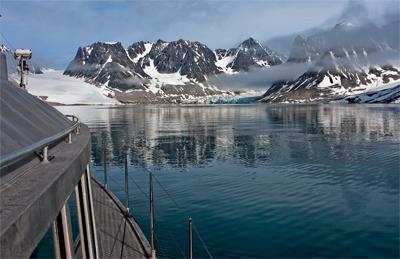
Fully protected anchorages don’t exist in this part of the world. Wind and current can bring the ice pack to visit if you are in the northern islands, or glacier and sea ice anywhere else. On two occasions, ice will chase us out of anchorages. Cruising here is not for the faint of heart, but the rewards make it worth the effort. Visiting Svalbard is a visual treat beyond almost anything else on the planet. Sixty percent of the islands are covered with ice and there are tidewater glaciers everywhere we look. There is a breathtaking contrast between the stark white of the ice, bare rock, blue sky, and dark water. Less than 14 inches of precipitation fall in an average year, making this a virtual desert. Between the glaciers, rock, and climate, just 10 percent of the land mass has any ground cover during the short summer.
And there is abundant wildlife. Millions of sea birds, whales, walrus, seals, fox, reindeer, and polar bear share their habitat with us.
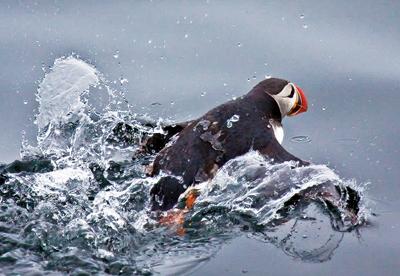
European exploration of Svalbard began in the latter part of the 16th century with William Barents doing a bit of coastal cruising during 1596. Initially driven by the quest for a shorter route to the Indies, whaling and then fishing quickly became the draw. Seventeenth- through 19th-century explorers and whalers worked their way through the ice pack as far as 82 degrees north, under sail, without benefit of global warming or internal combustion engines. The 20th century brought coal mining to the islands. More recently, tourism has become the main economic thrust.
There is also a history of Arctic exploration, in particular the race to the North Pole. Names like Amundsen and Nansen are etched in the history of Svalbard. The dry Arctic climate is especially good at preserving remains and the islands abound with artifacts.
Now, a deck of low clouds hangs over us. There is ice pack to the west and northeast but it looks clear directly to the north. After 20 minutes—and a hearty meal of burritos, salad, and fruit—the fog has lifted enough to tempt us farther north.
The entire Polar ice pack is in constant motion, drifting with ocean currents and wind. The same is true of the open leads in the ice around the perimeter of the pack, which can change position with disconcerting swiftness.
2020, Position 79.49.2N Latitude 012.22.1E Longitude.
Just 12.3 miles to go. The cloud ceiling has lifted to 2,000 feet and visibility has improved. But the west wind is increasing, now to 10 knots, and the ice leads ahead are less open. We need four hours to get to 80 degrees, and back to this point, allowing for a zigzag course in the leads. If the breeze builds much more we will have to turn back. But if it holds steady, we are probably okay.
Earlier this morning, we departed from Ny Alesund, a research village located at the sight of a former coal mine. Nine countries have facilities here to study polar phenomenon. During the summer, 200 hardy scientists call this home. There is a tiny harbor, partially protected by a small breakwater, into which Wind Horse barely fits. Ashore, there is a small store, museum, dormitories, a communal cafeteria, and research facilities. Ny Alesund also boasts the northernmost post office on the planet. This prosaic description, however, does not do justice to the ambiance.
Under a low, overcast sky and weak sunlight, a giant satellite dish and the remains of a coal mine combine to give the surroundings an otherworldly feel. This could easily be a remote outpost on the cold moon of a different planet. Walking into the log cabin bar, we half expect a scene from “Star Wars” to unfold.
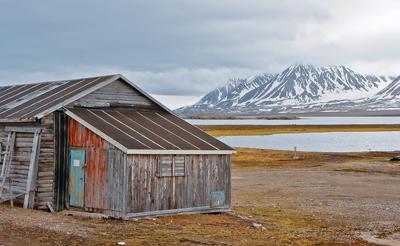
Moving down the “main street” yields a different sensation. Think of Clint Eastwood’s film High Plains Drifter and you have the setting down cold. Replace rugged frontiersmen with scientists suited up and armed for survival (nobody takes the polar bears lightly) and the scene is complete.
Polar bears move with seals, which in turn follow the ice pack. As fjord ice melts and the polar pack heads north, this mammalian food chain retreats with the ice. Bears who miss the ice retreat are left to scavenge the islands, trying to subsist on birds’ eggs, the odd seal, or, if lucky (or unlucky depending on perspective) the occasional biped.
They are intelligent hunters who carefully stalk their prey, going so far as to cover their black noses with snow to hide from seals. They are also good climbers, often erupting from the sea to take seals on the ice edge. And they can run 20 miles per hour for short distances.
Due to the bears’ migratory pattern, yachts visiting Svalbard rarely see polar bears.
Ny Alesund is on one arm of a complex of fjords known as Kongsfjorden. The glaciers in Krossfjorden are active right now, and as the sun is shining, we carefully spring and warp our way out of Ny Alesund’s tiny harbor and head northwest. A couple of wondrous hours of sightseeing has us at the edge of the ice floes off Lilliehookbreen glacier. This is the perfect spot for a photo of the boat surrounded by ice with a giant glacier face in the background, and we prepare to launch the dinghy.
While we are releasing the lashings, Joe is scanning for wildlife with his 15-power binoculars. The launching halyard is being wound around the electric winch when Joe shouts “Polar bear! He’s swimming across the fjord, just off the port bow, 100 yards off.”
We grab cameras and observe Mr. Bear cross the fjord. He paddles at an easy three knots, faster than you could row an inflatable with a balky outboard. Had Joe not seen him, and had we launched the dinghy, one of us might not now be writing this story. Reaching the shoreline, the polar bear lunges up on the boulder-strewn beach, and leisurely proceeds up the steep mountain at a pace you could not duplicate running on flat ground. At the summit he pauses and looks over his shoulder at us as if to say “next time.”
We’ve been close up and personal with Alaskan grizzlies, shared coves with cavorting humpback whales, and watched 20-foot crocodiles swim past our anchored yacht, but nothing we’ve seen in the past compares to being in the same fjord as a polar bear.
Our next stop, Magdelena Fjord, boasts the closest thing to a fully protected anchorage Svalbard offers. There is a sandy hook forming a natural breakwater, with good holding in mud and sand. It was one of the favorite anchorages for whalers during the past 300 years. Numerous graves give evidence to how tough that life was. There are four tidewater glaciers in the vicinity, and the scenery is as spectacular as anything we have seen in a lifetime of cruising.
This is a government outpost. A cabin houses two rangers in the summer, an isolated, coveted position. The rangers come by to check our papers and we invite them aboard for a home-cooked meal.
Everywhere these two men travel they are prepared for the worst. From dry suits worn in the dinghy (the norm for everyone in small boats here) to rifles, high-powered pistols, and heavy-duty flare guns, it is evident they respect the king of the food chain. When we inquire about the chances of seeing a bear in Magdelena, they reply that they have not seen one all summer.
The next day dawns with brilliant blue skies and we take the dinghy ashore to explore. Arctic terns fly about our heads, daring us to try to find their nests. The black-and-white scenery is framed by dark blue sky and darker water. We step carefully, avoiding the tiny, beautiful flowers which eke out an existence during the short summer.

Our new friends, the rangers, are off counting reindeer (a subspecies of caribou) and we have Magdelena Fjord to ourselves. Joe is a little uncomfortable with the rocky terrain around the beach. He points out what good cover this would give a hungry polar bear, and we are a quarter of a mile from the dinghy. Even though there have been no sightings this summer, we head back.
Until 20 years ago, you were not allowed to carry firearms when ashore. Then a camper was taken from his tent right here in Magdelena, and eaten on the ice just off the beach, in full view of his helpless friends. The government changed their rules on self defense.
Two weeks after our visit, three yachts are in Magedelena. One of the crews is walking on shore. Another has climbed the mast for a photograph, and he suddenly yells to get the attention of the folks ashore. When they do not respond, his partner jumps into their dinghy and roars off to the beach. The photographer aloft has spotted a polar bear swimming ashore and all concerned beat a hasty retreat.
2124. Our Furuno GPS Says 80° 00.2’N.
We’ve made it! The leads are still open, but the west wind has now increased to 15 knots, and though we’re tempted to push even closer, we are concerned that the ice behind us may close. Wind Horse has come within 598 miles of the North Pole and we feel on top of the world.

